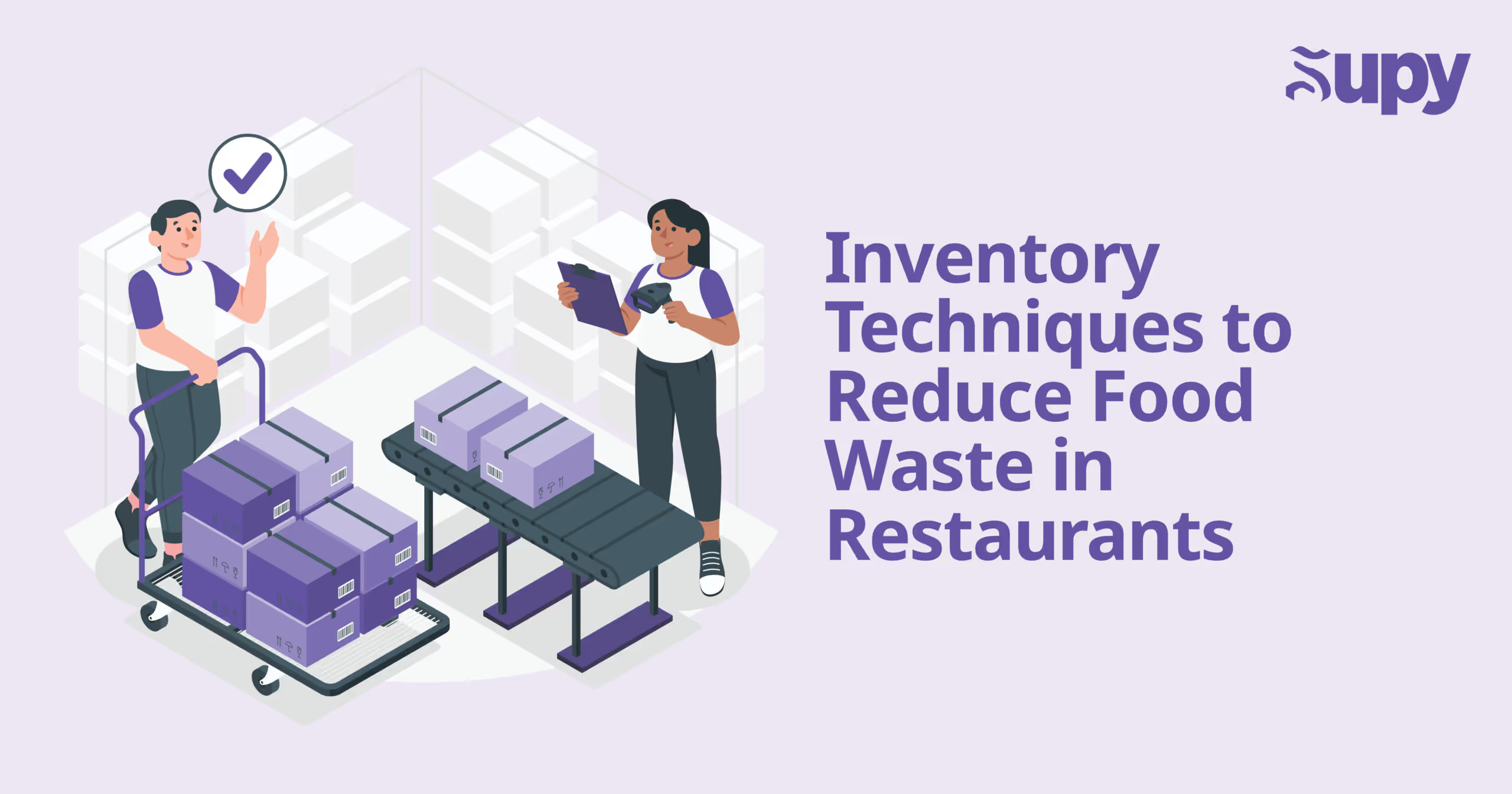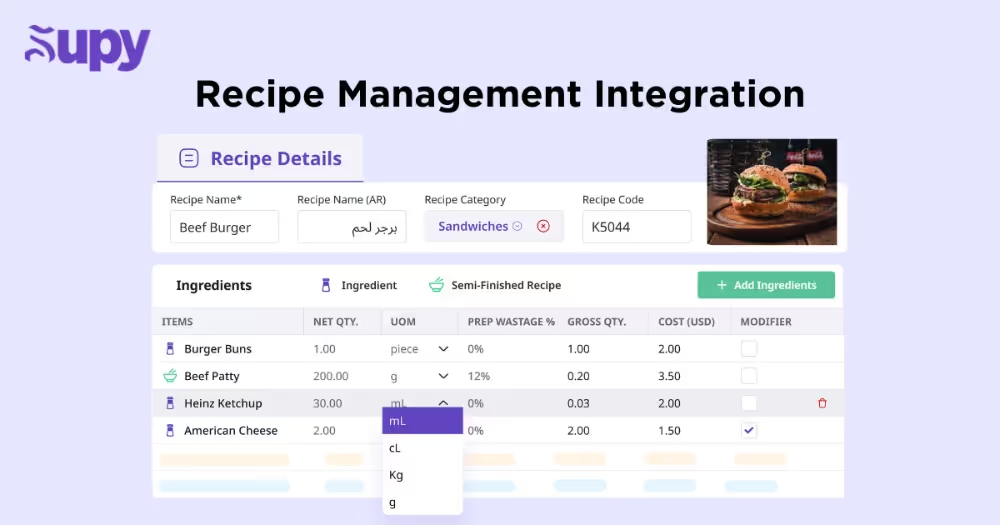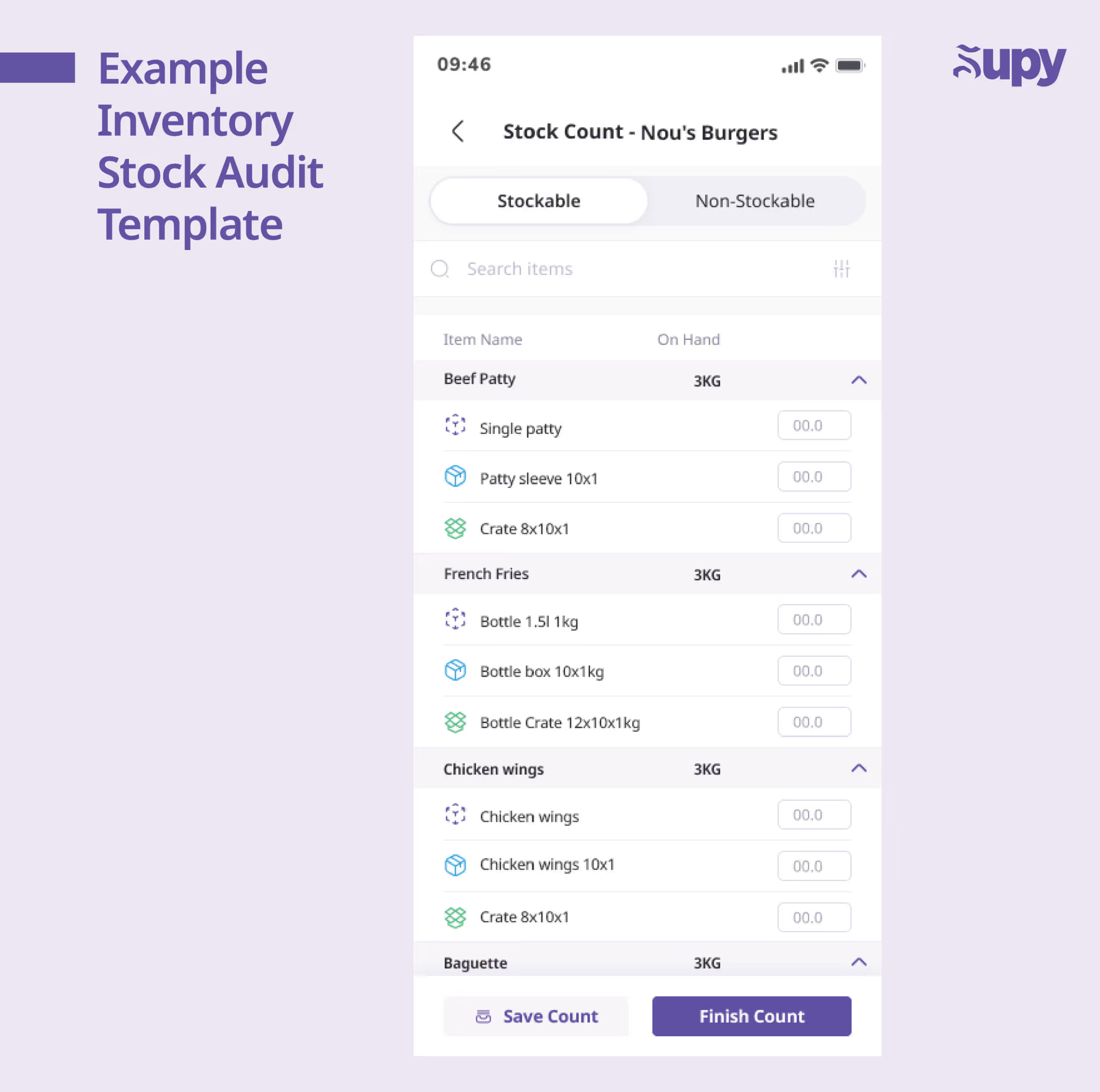Inventory Techniques to Reduce Food Waste in Restaurants

It’s painful to throw money in the trash at the end of the night. But that’s exactly what’s happening in restaurants every day.
Studies show that 4% to 10% of food in commercial kitchens goes to waste, often due to spoilage, over-ordering, or poor inventory tracking. And the cost? It adds up, with tens of thousands of dollars lost each year directly from your bottom line.
The good news is that every dollar invested in reducing food waste brings back $7 in savings. Smarter inventory management is one of the simplest ways to unlock those savings without adding extra work for your team.
In this blog, we’ll cover:
- Common Causes of Food Waste in Restaurants
- Technique 1: Implement FIFO and Proper Stock Rotation
- Technique 2: Set Par Levels to Avoid Overstocking
- Technique 3: Track Waste Events in an Inventory Log
- Technique 4: Use Inventory Data for Menu and Portion Adjustments
- Technique 5: Regular Inventory Audits and Training
- The Real Impact: From Lower Waste to Higher Profits
- Conclusion: Invest in Waste Reduction
- About Supy
1.Common Causes of Food Waste in Restaurants
In a busy kitchen, it doesn’t take much for food waste to pile up. Without the right systems, produce gets lost in the walk-in, portion sizes vary by the hour, and no one’s tracking what gets tossed. Over time, those small slips turn into big costs.
Here are the most common reasons food waste happens:
- Overordering: Without accurate usage data, it’s easy to stock more than you need. This often results in surplus food that spoils before it’s used.
- Improper storage: Ingredients stored at the wrong temperature or in the wrong containers can go bad quickly, even if they were fresh on arrival. That’s a major cause of pre-consumer food waste.
- Not using FIFO: When older stock is left behind and newer items are used first, it leads to wasted food that could have been served.
- Unpredictable demand: Without clear visibility into sales patterns, teams over-prepare for slow nights or under-prepare for rushes. Both scenarios create food waste challenges that are hard to manage without proper data.
- No waste tracking system: If staff aren’t recording what gets thrown out and why, there’s no way to identify or fix recurring problems.
- Inconsistent portioning: When serving sizes vary from shift to shift, it leads to overproduction and leftover food that often goes uneaten.
- Menu complexity: Too many SKUs or overlapping ingredients across dishes can lead to low turnover of niche items that spoil faster.
- Prep mistakes or cooking errors: Burnt, overcooked, or incorrectly prepared food often ends up wasted, especially during busy hours.
- Lack of staff training: When staff don’t understand proper handling, storage, or portioning techniques, food is more likely to be wasted at every step.
2. Technique 1: Implement FIFO and Proper Stock Rotation
One of the simplest and most effective ways to support food waste reduction is by following the FIFO (First-In, First-Out) method. That means using older stock before newer items. But without a system to support it, FIFO often falls apart during busy shifts.

Here’s how to put FIFO into practice and make it stick:
- Label everything clearly: Every item that comes into your kitchen should be labeled with the date it arrived or its expiration date. This makes it easy for staff to spot what needs to be used first. Color-coded day labels or printed stickers from your inventory system can speed this up and reduce guesswork, helping you store food properly and keep operations organized.
- Organise storage for visibility: Place older stock in front and newer deliveries at the back, both in the walk-in and on dry storage shelves. Make it effortless for staff to grab the right item without digging. This simple habit protects your food safety standards by avoiding overlooked stock that may spoil.
- Use inventory software with expiry tracking: Digital tools like Supy can track expiration dates and send alerts before items go bad. This gives you time to act, whether adjusting prep plans or creating a quick special using remaining edible food that might otherwise be wasted.
- Train staff on rotation routines: Make FIFO part of your kitchen culture. Include it in onboarding and reinforce it during daily prep. When everyone follows the same system, it becomes second nature and helps extend the shelf life of ingredients by reducing handling errors.
- Review and adjust weekly: Schedule regular walkthroughs to check if FIFO is being followed. Small habits like misplacing labels or skipping rotation during a rush can quickly lead to spoilage.
3. Technique 2: Set Par Levels to Avoid Overstocking

Overordering is one of the most common ways restaurants lose money to food waste. Without clear targets, it’s easy to stock up “just in case” and end up tossing spoiled ingredients by week’s end.
Setting par levels, the ideal quantity of each item you should keep on hand, helps prevent this.
Here’s how to set and manage par levels effectively:
- Track usage over time: Use your inventory system to review past usage for each ingredient. Look at data across weeks and different seasons to understand true demand. If your kitchen goes through 15 kg of onions a week, but you keep ordering 25 kg, you're almost guaranteed to waste some.
- Establish par levels based on patterns: Once you know how much you actually use, set a par level for each item. This becomes your guide, only reorder when the stock drops below this number. Par levels should reflect how fast an item moves and how quickly it spoils. Perishables = lower par. Shelf-stable items = higher par.
- Get alerts when you exceed par: Supy helps you set custom par levels and automatically flags when you’re overstocking. That means no more guessing and better control over how much food is purchased at any given time.
- Train staff to follow the system: Everyone involved in ordering should understand par levels and stick to them. No more ordering by gut feeling or overestimating busy periods.
- Adjust regularly: Menu changes, seasonality, and customer trends all impact usage. Review par levels monthly to stay aligned with real demand.
4. Technique 3: Track Waste Events in an Inventory Log
You can’t fix what you don’t measure. And in many kitchens, food gets tossed without anyone recording why. Spoilage, prep errors, and overcooked items, all quietly disappear into the bin, day after day.
Here’s how to use a waste log effectively:
- Record every waste event: Whether it’s a burnt batch of rice or spoiled lettuce, log it. Use your inventory platform to tag what was wasted and why (e.g., spoilage, overcooked, dropped, incorrect prep). Make it easy for staff, create dropdown categories and allow quick mobile entry so it doesn’t slow down the shift.
- Review the log weekly: Patterns emerge quickly. Maybe soup is over-prepped every Tuesday. Or a particular item is consistently spoiling before it’s used. These insights help managers make small but impactful changes.
- Use the data to adjust processes: Tracking waste helps you fine-tune par levels, prep routines, portion sizes, and even your menu. Small tweaks lead to major savings over time.
- Make it a team habit: When staff understand that waste logs aren’t about blame, but about improvement, they’re more likely to participate.
5. Technique 4: Use Inventory Data for Menu and Portion Adjustments
Inventory data shows more than what’s being used. It highlights what’s regularly wasted and points to dishes that may need a portion adjustment or a recipe update.
Here’s how to use it:
- Identify high-waste menu items: Look at your inventory and waste logs to see which ingredients are consistently over-ordered or underused. Often, they’re tied to specific dishes.
- Tweak recipes and portion sizes: Once you’ve spotted the culprits, adjust accordingly. That could mean swapping out ingredients, offering smaller portions, or removing low-performing items from the menu entirely.
- Use recipe-level tracking to stay consistent: Supy can link ingredient quantities to each dish through menu engineering. That means every staff member knows the exact amount to use, reducing plate waste.
- Train staff to portion correctly: Use scoops, ladles, and scales to help staff serve consistent amounts. Combine this with regular training and recipe management so the kitchen stays aligned.
6. Technique 5: Regular Inventory Audits and Training
Even with good systems in place, waste can still creep in when no one’s looking. That’s why regular inventory and food waste audits and team training are essential. A weekly inventory check helps you catch problems early, before they become patterns.

Here’s how to build this habit and make it stick:
- Schedule weekly inventory audits: Pick a consistent day and time when inventory can be checked without disrupting operations. Focus on high-risk items like produce, proteins, and dairy. Use your pre-made templates to speed up counts and compare real-time stock to expected levels.
- Involve your team: Instead of assigning audits to one person, rotate the responsibility. When staff are part of the process, they’re more mindful of how ingredients are handled.
- Use mobile apps to make it easy: Supy allows quick, app-based inventory checks. That removes the friction of clipboards and spreadsheets and helps teams log data accurately on the go.
- Train staff on the cost of waste: Don’t assume everyone knows what food waste really costs. Use real examples from your own kitchen to show how waste impacts margins, and how small changes make a difference.
7. The Real Impact: From Lower Waste to Higher Profits
Small changes in how you manage inventory can lead to big savings. Even reducing food waste by 2% can lower your food cost percentage and create a noticeable lift in profit margins. For a mid-sized restaurant, implementing these techniques could easily save tens of thousands of dollars each year. That’s money staying in your business instead of ending up in the bin.
Take Pitfire Pizza as an example. Using Supy, they gained visibility into actual versus theoretical food costs and uncovered a $55,000 loss tied to over-portioned mushrooms. With clear reporting and better controls, they fixed the issue in just one month. Supy also helped them reduce manual errors, simplify central kitchen transfers, and tighten up their overall operations.

8. Conclusion: Invest in Waste Reduction
Tackling restaurant food waste is one of the most straightforward ways to boost profitability. It’s like unlocking free money, once you stop throwing it away. Most food waste is preventable with the right systems and habits in place.
Start small. Implement one technique at a time and build momentum. The goal isn’t perfection overnight, it’s progress that sticks. And with tools like Supy, you don’t have to do it alone. It helps you automate and sustain food waste reduction practices so your team can stay focused on running a successful kitchen.
Here are a few more ways to reduce waste and turn food loss into opportunity:
- Repurpose safe food scraps into soups, sauces, or daily specials.
- Partner with food rescue organizations to donate leftover but safe-to-eat food.
- Set up a program with local food banks to share surplus meals.
- Standardize prep and portion sizes to limit overproduction.
- Track top-wasted items and build staff awareness through regular reviews.
9. About Supy
Supy is built to make restaurant inventory smarter, faster, and more accurate. It replaces guesswork with real-time data, helping you reduce overordering, track waste, and control food costs at every step.
With features like:
- Expiry alerts and FIFO support
- Actual vs. theoretical cost tracking
- Easy waste logging with custom reasons
- Par-level alerts to prevent overstocking
- Role-based permissions for better team accountability
Supy gives you the visibility and control you need to run a leaner, more profitable kitchen—without adding more to your plate.
Ready to cut waste and save money? Book a free demo with Supy today.
Related Resources
- Webinar : The Food Cost Reduction Secrets Of Multi-Branch Businesses
- How To Calculate Food Cost Percentages
- 10 Ways To Reduce Food Cost - 2024 Edition
- 10 Tips To Reduce Restaurant Food Waste
Take your hospitality business
to the next level
FAQ
Why is reducing food costs important for a restaurant?
Reducing food costs is essential for maximizing profit margins, minimizing waste, and improving the overall financial health of a restaurant.
What is a sustainable food cost percentage for a restaurant?
A sustainable food cost percentage typically falls between 28-35%, though it varies by restaurant type and pricing strategy.
How can portion control help reduce food costs?
Portion control prevents ingredient overuse, ensuring that food costs remain consistent and predictable across dishes.
What is the impact of bulk purchasing on food costs?
Bulk purchasing often lowers the per-unit cost of ingredients, but it should be balanced with storage capacity to prevent waste.
How does an inventory management system help reduce food costs?
An inventory system helps track ingredient usage, prevent over-ordering, and reduce waste, thereby lowering overall food costs.
Why is monitoring waste essential for reducing food costs?
Monitoring waste allows restaurants to identify sources of loss and implement waste-reduction practices to save on food expenses.
How can menu engineering reduce food costs?
Menu engineering helps identify high-cost/low-profit items, allowing adjustments in pricing, ingredients, or portion sizes to improve profitability.
What role does staff training play in food cost management?
Training staff on portion control, waste reduction, and efficient food handling can significantly lower food costs by reducing errors and waste.
How does sourcing local ingredients help reduce costs?
Local sourcing often reduces transportation costs and shortens the supply chain, potentially lowering food costs while supporting local economies.
What is the benefit of negotiating with suppliers?
Negotiating can secure better pricing, payment terms, or discounts, helping to reduce overall ingredient costs.
How does monitoring food cost variance assist in reducing food costs?
Monitoring variance identifies discrepancies between expected and actual costs, allowing adjustments to maintain budget targets.
What is the value of a standardized recipe in cost control?
Standardized recipes ensure consistency, control ingredient costs, and maintain portion sizes, which aids in food cost management.
How can seasonal menu adjustments reduce food costs?
Seasonal adjustments allow restaurants to use ingredients when they are most abundant and affordable, helping to lower food costs.
What impact does reducing food waste have on food costs?
Reducing waste minimizes losses, helping restaurants save money by fully utilizing purchased ingredients.
Why is accurate forecasting important for food cost control?
Accurate forecasting helps align inventory with demand, minimizing waste and preventing overstocking of perishable goods.
How can technology assist in reducing food costs?
Technology, such as Supy’s inventory management tools, enables real-time tracking, demand forecasting, and data analysis to optimize purchasing and reduce waste.
What are some best practices for managing perishable inventory?
Best practices include using the FIFO method (First In, First Out), labeling expiration dates, and regularly checking inventory for spoilage.
How does supplier consistency impact food cost management?
Consistent suppliers reduce the risk of unexpected price changes, enabling more predictable food cost management.
What role does menu pricing play in food cost control?
Properly priced menu items ensure profitability by covering ingredient costs and contributing to overhead and labor expenses.
How can cross-utilization of ingredients reduce food costs?
Cross-utilizing ingredients across multiple dishes minimizes waste and allows bulk purchasing of key ingredients, reducing overall costs.







